A recording of the original presentation is available.
Slide 1
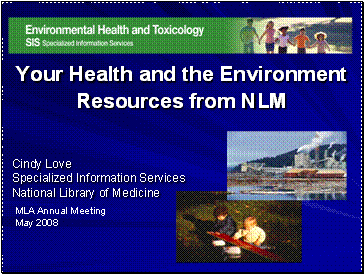
Your Health and the Environment
Resources from NLM
Cindy Love
Specialized Information Services
National Library of Medicine
The environment plays an important role in human development and health. Researchers have linked exposures to some environmental hazards with specific diseases, such as the link between exposure to asbestos and lung cancer and the link between exposure to lead and decreased mental function in children. Other linkages are more difficult to determine, especially when exposures to multiple chemicals or other types of agents occur. Ambient air pollution, worker exposure to chemicals, indoor air pollution, and drinking water quality are among the top four threats to human health.
Slide 2
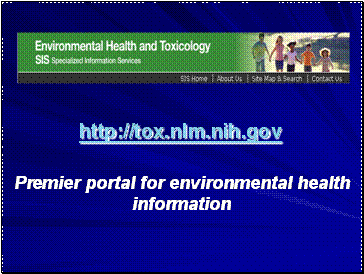
//tox.nlm.nih.gov
Premier portal for environmental health information
The NLM Division of Specialized Information Services (SIS) environmental health and toxicology portal can be found at http://tox.nlm.nih.gov. This is the starting point for information on chemicals, drugs, chemical, biological and radiation weapons, and environmental health issues.
Slide 3
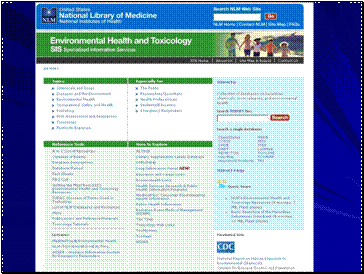
Environmental Health and Toxicology homepage
NLM’s toxicology and environmental health information portal links health professionals and the public to many resources produced by NLM and other organizations. Today, I’ll show you a few highlights and give you an overview of new or updated resources. You’ll find all of them at the “tox” URL on the pens we distributed. I encourage you to use this page as a jumping–off point for exploring the wide range of resources we have in environmental health.
Slide 4
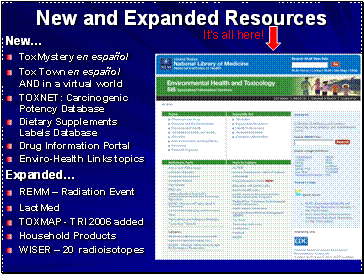
New and Expanded Resources
New…
- ToxMystery en español
- Tox Town en español AND in a virtual world
- TOXNET: Carcinogenic Potency Database
- Dietary Supplements Labels Database
- Drug Information Portal
- Enviro-Health Links topics
Expanded…
- REMM – Radiation Event
- LactMed
- TOXMAP - TRI 2006 added
- Household Products
- WISER – 20 radioisotopes
First, I’m going to review our teaching resources for K-12 and up, newly available in Spanish.
Then give an overview of new and expanded environmental health resources including the TOXNET collection of toxicology databases.
At the end, I’ll also introduce our newest venture in expanding NLM ‘s disaster information efforts.
***************
New for 2007 and ’08 include:
- ToxMystery en español for kids ages 7-10
- Tox Town en español AND in a virtual world
- Dietary Supplements Labels Database
- Drug Information Portal
- New titles in the Enviro-Health Links series
- TOXNET: Carcinogenic Potency Database
Expanded and upgraded resources include:
- REMM – Radiation Event Medical Management
- LactMed
- TOXMAP - TRI 2006 added
- Household Products
- WISER – 20 radioisotopes
Slide 5
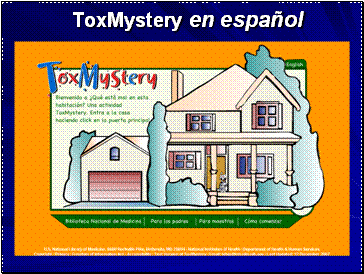
ToxMystery en español
ToxMystery, designed for 7-10 year olds, allows kids to explore a house and find potential hazards in the house. Introduced last year, it is now available in Spanish for either reading or listening. Multiple choice questions are asked and once all the hazards are correctly identified, a certificate can be printed.
It’s available on the web or on CD. Ring the doorbell and …
Slide 6
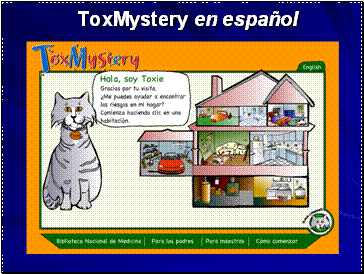
ToxMystery en español
…Toxie will greet you in Spanish and help you explore room by room for household hazards like …
Slide 7
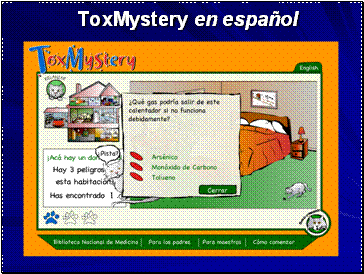
ToxMystery en español
… the _____ found in this bedroom.
Also now in Spanish…
Slide 8
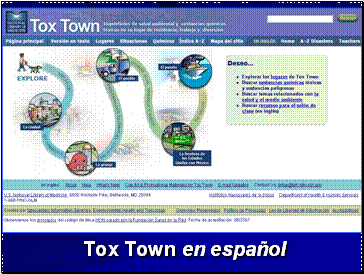
Tox Town en español
…we have Tox Town which is intended for high school and college students and the public. Here’s the new Tox Town home page in Spanish.
Descriptions of nearly 100 toxic chemicals and environmental health concerns have been translated. Also 5 th birthday redesign – the English pages look just like these new Spanish pages. All content is now available in Spanish and English, both a graphic version and a text version.
Slide 9
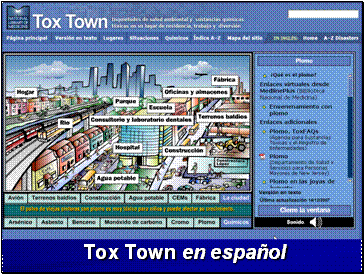
Tox Town en español
The neighborhood scenes of the City, Port, Farm, US Mexico Border and Town are now available in Spanish. Here you can see locations where you might find lead (plomo) and links to Spanish-language information on lead.
Slide 10
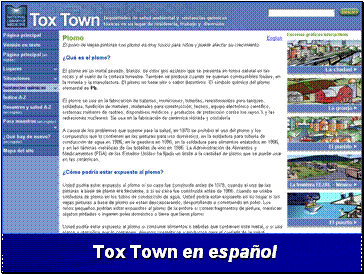
Tox Town en español
For the Spanish version we translated descriptions of nearly 100 toxic chemicals and environmental health concerns. For example, this page shows you the description of lead - what is it? And how can it affect my health?
Slide 11
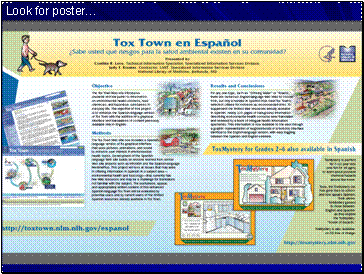
Tox Town en español poster
There’s a poster on the Spanish version that will be up during the poster sessions and I have handouts up here if you’d like one.
Slide 12
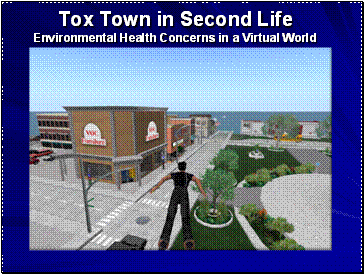
Tox Town in Second Life
Environmental Health Concerns in a Virtual World
We’re also experimenting with Tox Town in the virtual world Second Life. We’ve built an island that illustrates many of Tox Town’s environmental health concerns and includes all the toxic chemicals. There’s also a recreation of the NLM main building that can host rotating exhibits and in-world meetings. The island will “open” in the next month or so.
**************
(SL) are growing in popularity as platforms for educational and collaboration applications.
NLM’s Tox Town lends itself naturally for a highly interactive 3-D environment like SL.
NLM/SIS is developing a prototype 3-D Tox Town that will provide information about the capabilities and limitations of Virtual Worlds for health information applications.
Slide 13
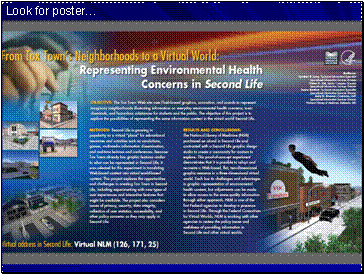
Tox Town in Second Life poster
There’s also a poster at MLA about this project and I have handouts up front.
Slide 14
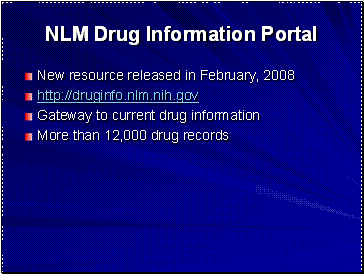
NLM Drug Information Portal
- New resource released in February, 2008
- http://druginfo.nlm.nih.gov
- Gateway to current drug information
- More than 12,000 drug records
Moving to resources for health professionals and the public…
We introduced the Drug Information Portal in February. This is an NLM-wide effort to present a coherent, organized, user-friendly portal to drug information from the entire federal government.
**********
NLM/NIH Drug Information Resources
Summary of drug information (MedlinePlusDrug)
Summary of consumer health information (MedlinePlusTopics)
Summary of HIV/AIDS treatment (AIDSinfo)
Summary of the effect on breastfeeding (LactMed)
Summary of reviewed biological and physical data (HSDB)
Summary of ingredients and label information (Dietary Supplements Labels Database)
References from scientific journals (Medline/PubMed)
References from toxicological journals (TOXLINE)
Manufacturers drug label (DailyMed)
Clinical trials (ClinicalTrials.gov)
Biological activities and chemical structures (PubChem)
Biological activities against HIV/AIDS and other viruses (NIAID ChemDB)
Toxicological and chemical resources (ChemIDplus)
Other Drug Information Resources
Information from the US Food & Drug Administration (Drugs@FDA)
Information from the US Drug Enforcement Administration (DEA)
Search engine for other government resources (USA.gov)
Slide 15
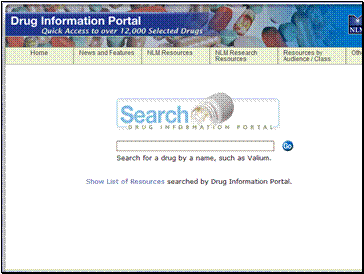
NLM Drug Information Portal search page
You can see it has a very straight-forward search page….
Slide 16
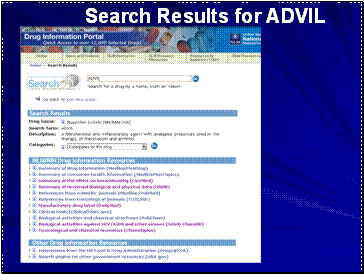
NLM Drug Information Portal search results for ADVIL
…and here are the results you can expect. Each of more than a dozen locators will take you to the web resource or database with information on that drug. Gale Dutcher will be giving a much more in-depth look at this new resource here on Sunday at 1:30 and Monday at 3:30.
**************
It includes information such as summaries of the effect on breastfeeding and of reviewed biological and physical data, articles from scientific journals and from Toxicological Journals, m anufacturers drug label information, Clinical Trials information, biological activities and chemical structures, and t oxicological and chemical resources links.
NLM/NIH Drug Information Resources
Summary of drug information (MedlinePlusDrug)
Summary of consumer health information (MedlinePlusTopics)
Summary of the effect on breastfeeding (LactMed)
Summary of reviewed biological and physical data (HSDB)
References from scientific journals (Medline/PubMed)
References from toxicological journals (TOXLINE)
Manufacturers drug label (DailyMed)
Clinical trials (ClinicalTrials.gov)
Biological activities and chemical structures (PubChem)
Biological activities against HIV/AIDS and other viruses (NIAID ChemDB)
Toxicological and chemical resources (ChemIDplus)
Other Drug Information Resources
Information from the US Food & Drug Administration (Drugs@FDA)
Search engine for other government resources (USA.gov)
********
About this Portal
The NLM Drug Information Portal gives users a gateway to selected drug information from the National Library of Medicine and other key government agencies. At the top of the page are links to individual resources with potential drug information, including summaries tailored to various audiences. Resources include the NLM search systems useful in searching for a drug, NLM research resources, resources organized by audience and class, and other NIH and government resources such as FDA and CDC.
The search box in the middle of the page lets you search many of these resources simultaneously. More than 12,000 drugs can be searched using this facility. The portal covers drugs from the time they are entered into clinical trials (Clinicaltrials.gov) through their entry in the market place (Drugs@FDA). The PubMed/Medline link provides medical literature describing research, and TOXLINE provides toxicology literature. Resources such as MedlinePlus provide easy to read summaries of the uses and efficacy of a drug.
You may search by a drug’s trade name or generic name. For example, the trade name “Advil” and the generic name “ibuprofen” will retrieve the same drug record. A spell checker gives suggestions if the name is not found. You can find embedded portions of names by using an asterisk at the beginning and/or end of a search term. Once a drug is found, a summary of the drug’s type and usage is given, as well as links leading to further information at one of the portal’s resources. Outside links open in a new window. Within a given drug record, you may click on the drug category and retrieve drugs with the same or similar uses.
JavaScript must be enabled in your browser for the NLM Drug Information Portal to work properly.
***************
Resources by Audience / Class
By Audience The Public Health Professionals Researchers Librarians Student/Educators Population Groups By Class Prescription Over-the-counter Dietary Supplements Drugs of Abuse Investigational
Slide 17
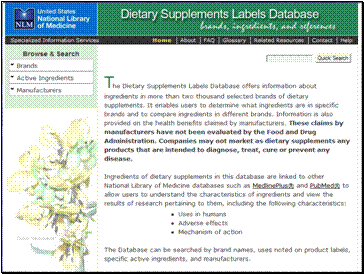
Dietary Supplements Labels Database
The Drug Information Portal helps you locate web resources about a drug and here is one of the resources it points to.
The Dietary Supplements LABELS Database contains information on the ingredients of over 2,000 brands of dietary supplements sold in the U.S. and is designed to help not only researchers, but the large audience of supplement consumers as well.
While consumer-oriented information about dietary supplements is available from many sources, this database consolidates and centralizes the information that consumers require to make informed decisions about supplements and provides direct links to pertinent health information and on-going clinical studies at the National Institutes of Health (NIH).
**********************
The database is designed to help answer the following typical questions:
- What are the ingredients in specific brands?
- Which brands contain specific chemical ingredients?
- What fraction of daily recommended nutrients is provided by a specific brand?
- Can I compare the amount of a specific nutrient between brands?
- What are inactive ingredients in each brand?
- Which brands do not contain animal products?
- Can I find studies that indicate the proven medical benefits of specific ingredients?
- Can I find information on the toxicity of specific ingredients?
- Who manufactures a specific brand? How do I contact this manufacturer?
- What other information is available about chemicals in the toxicology-related databases of the National Library of Medicine?
Slide 18
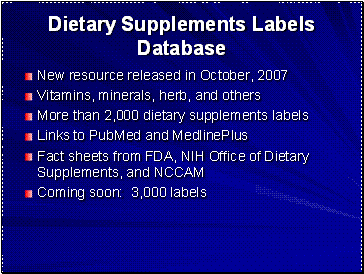
Dietary Supplements Labels Database
- New resource released in October, 2007
- Vitamins, minerals, herb, and others
- More than 2,000 dietary supplements labels
- Links to PubMed and MedlinePlus
- Fact sheets from FDA, NIH Office of Dietary Supplements, and NCCAM
- Coming soon: 3,000 labels
The database was released last October.
Remember, this website does not test, approve or evaluate products in any way. It reprints the information found on the product label and provides links from those listed ingredients to drug, chemical, and toxicology resources, PubMed citations, MedlinePlus, clinical trials and National Center for Complementary and Alternative Medicine at NIH.
************************
“The label claims have not been evaluated by the Food and Drug Administration. This product is not intended to diagnose, treat, cure or prevent any disease. Consult your healthcare professionals before taking any dietary supplements.”
Slide 19
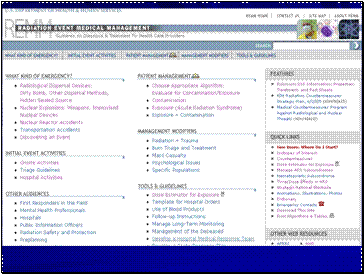
Radiation Event Medical Management
Moving away from drugs and supplements, I want to give you an update on two resources, REMM and WISER, that may prove invaluable in disaster response.
First is REMM, the Radiological Event Medical Management system, released in early March last year.
REMM gives health care providers guidance on diagnosis and treatment in the event of a radiation emergency. It represents a collaboration of NLM with HHS office of the Assistant Secretary for Preparedness and Response.
REMM is designed for Health Care Providers (HCPs) without formal expertise in radiation safety or radiation medicine who may provide medical care during an accidental or non-accidental Radiation Event. This site is not specifically designed for the general public.
PLEASE! Very important to download to CD, keep one in the ER, one in the hospital library and one at home.
Slide 20
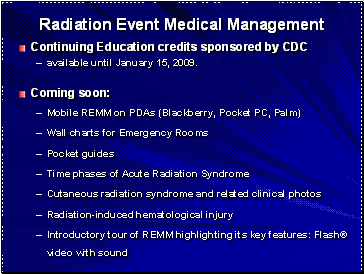
Radiation Event Medical Management
- Continuing Education credits sponsored by CDC
- available until January 15, 2009.
- Coming soon:
- Mobile REMM on PDAs (Blackberry, Pocket PC, Palm)
- Wall charts for Emergency Rooms
- Pocket guides
- Time phases of Acute Radiation Syndrome
- Cutaneous radiation syndrome and related clinical photos
- Radiation-induced hematological injury
- Introductory tour of REMM highlighting its key features: Flash® video with sound
Here are some of the upcoming additions to REMM. It will have expanded clinical information as well as new ways to convey the most important information through use of PDAs and printed materials.
You can also earn CME credit for an online lecture about REMM.
***************
Online lecture title: The Radiation Event Medical Management Web Portal — A Novel Resource for Health Care Providers
New pages…
- Radiological Exposure Device (RED)
- Training and Education
Slide 21
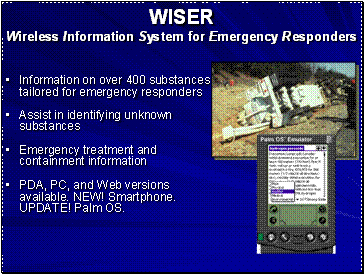
WISER
Wireless Information System for Emergency Responders
- Information on over 400 substances tailored for emergency responders
- Assist in identifying unknown substances
- Emergency treatment and containment information
- PDA, PC, and Web versions available. NEW! Smartphone. UPDATE! Palm OS.
In a very different kind of emergency situation, first responders may need to identify an unknown substance at an accident scene or mass casualty event. WISER offers the key info in a handheld PDA (now including Smartphones) WITHOUT REQUIRING access to the Internet.
********************
What is WISER?
The Wireless Information System for Emergency Responders
(WISER) is a system designed to assist first responders in hazardous material incidents. WISER provides a wide range of information on hazardous substances, including substance identification support, physical characteristics, human health information, and containment and suppression advice.
There have been over nearly 120,000 downloads of WISER onto PDAs and Windows lap or desktops since 2005.
A web version of WISER was released in early 2006. It provides the same functionality as the PDA version and can be used by emergency responders with pcs or laptops and Internet access either onsite or back at the main facility. It is also used as a training device for emergency responders.
Slide 22
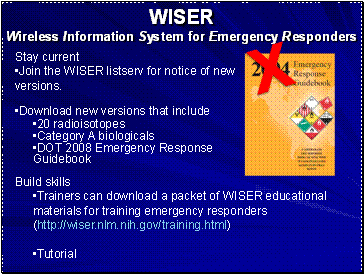
WISER
Wireless Information System for Emergency Responders
Stay current
- Join the WISER listserv for notice of new versions
- Download new versions that include
- 20 radioisotopes
- Category A biological
- DOT 2008 Emergency Response Guidebook
Build Skills
- Trainers can download a packet of WISER educational materials for training emergency responders (//wiser.nlm.nih.gov/training.html)
- Tutorial
It’s critically important that your user community sign up for the WISER listserv announcements of new versions and DOWNLOAD the new versions.
The recent updates, for example, include the DOT 2008 emergency response guidelines (orange book), published every 4 years.
AND added 20 new radiological agents (radioisotopes, see list below)
AND added Substance data for Category A biologicals:
- Anthrax (Bacillus anthracis)
- Botulism (Clostridium botulinum toxin)
- Plague (Yersinia pestis)
- Smallpox (variola major)
- Tularemia (Francisella tularensis)
- Viral hemorrhagic fevers (filoviruses [e.g., Ebola, Marburg] and arenaviruses [e.g., Lassa, Machupo])
February 18, 2008 - A WISER training package <http://wiser.nlm.nih.gov/training.html> is released: trainers are invited to download ready-made educational materials for training responders on the usage of WISER.
Also tutorial, //wiser.nlm.nih.gov/tutorial.html
*********************
Why is it important to get update information?
The information in WISER is derived from the peer-reviewed Hazardous Substances Data Bank, and we have conducted a verification process. However, updates to substance data may be made as more research is conducted. We would like to be able to inform you of important changes in the data, some of which may be critical for the safe use of the information.
//wiser.nlm.nih.gov/listserv_join.html
Radioisotopes:
Substances 1 through 30 of 30 (includes synonyms)
- Actinium, Radioacti ve
- Actinium-X
- Alphatron
- Americium, Radioactive
- Caesium, Radioactive
- Californium, Radioactive
- Cesium, Radioactive
- Cobalt, Radioactive
- Curium, Radioactive
- Hydrogen-3
- Iodine, Radioactive
- Ionizing Radiation (general data)
- Iridium, Radioactive
- Lead, Radioactive
- Lead- 214: RaB
- Neptunium, Radioactive
- Niton /Radon-222/
- Phosphorus, Radioactive
- Plutonium, Radioactive
- Polonium, Radioactive
- Potassium, Radioactive
- Radium emanation
- Radium, Radioactive
- Radon, Radioactive
- Strontium, Radioactive
- Thorium-X
- Triterium
- Tritium, Radioactive
- Uranium, Radioactive
- Yttrium, Radioactive
Slide 23
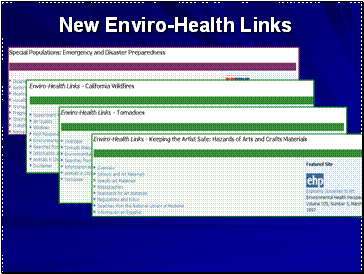
New Enviro-Health Links
While we’re on the subject of disasters and emergencies, I’ll mention several new
“web-liographies,” or lists of links on a variety of important or “hot” topics. In the past year, we’ve added Emergency and Disaster Preparedness for Special Populations, California Wildfires, and Tornadoes. And also information on “Keeping the Artist Safe: Hazards of Arts and Crafts Materials.”
*************
These lists of selected links include canned searches of several NLM databases, including PUBMED, TOXLINE, and HSDB.
The enviro-health links include some consumer health links, especially MedlinePlus, but also include more technical links as well.
Slide 24
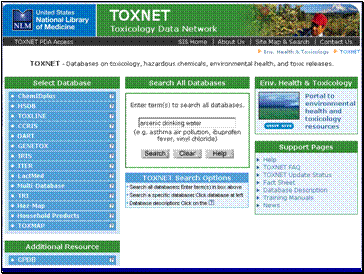
TOXNET
Let’s take a look at TOXNET, NLM’s premier toxicology and env. health resource.
All the resources I just reviewed are NOT searched in TOXNET. I’ll now give you an update on those that ARE included in TOXNET.
[TOXNET is a collection of a variety of types of databases, including online handbooks, bibliographic databases, information on the release of chemicals in the environment, and chemical names and structures.]
We’ve added one new resource this year, the Carcinogenic Potency Database, developed by the Carcinogenic Potency Project at the University of California, Berkeley, and by the Lawrence Berkeley National Laboratory.
[about: It reports analyses of animal cancer tests on 1547 chemicals. Results for each chemical are now searchable via TOXNET. CPDB includes 6540 chronic, long-term animal cancer tests (both positive and negative for carcinogenicity) from the general published literature as well as from the National Cancer Institute and the National Toxicology Program. Such tests are used in support of cancer risk assessments for humans. Information that is important in the interpretation of bioassays is reported in CPDB for each experiment.Users can search for results on each chemical in TOXNET via chemical name or name fragment, or by Chemical Abstracts Service Registry Number (RN). Results include a summary for each sex-species tested, including carcinogenicity, target organs, and carcinogenic potency values. Detailed results from each experiment on the particular chemical are given in a plot format suitable for screen viewing. Chemical structure, InChI, and SMILES codes are reported.]
Here is a sample TOXNET search. Enter your search, “arsenic drinking water” and all the databases listed on the left are searched
Slide 25
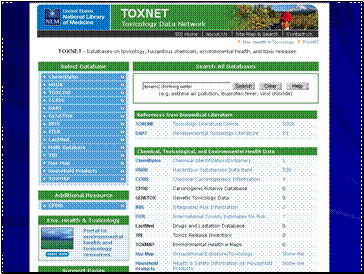
TOXNET Results Screen
The search results give you the number of records retrieved from each database that is part of TOXNET.
There have been updates to some of TOXNET’s components…
Slide 26
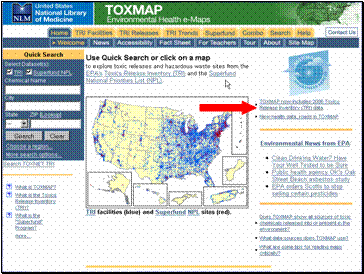
TOXMAP
…Let’s take a look at the TOXMAP home page
Data updates
** TOXMAP now contains the most recent Toxics Release Inventory data for 2006
** And has updated Cancer, mortality, and Income data
Slide 27
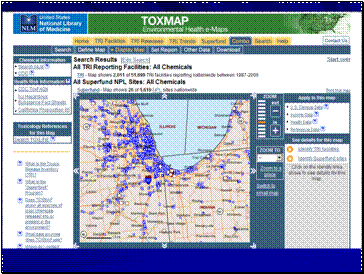
TOXMAP map of Chicago area
This map, generated by TOXMAP, shows all the manufacturing sites in the Chicago area that must report their releases to the EPA and shows Superfund contaminated sites.
[Toxmap includes data from the EPA Toxics Release Inventory and sites from the Superfund National Priorities List of contaminated sites waiting for clean-up]
Slide 28
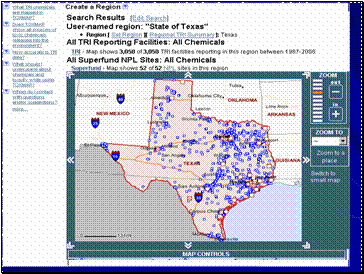
TOXMAP map of Texas
maps have been improved with more detailed mapping of roads and links from facilities to Google maps
You can now also create your own “Geographic Region” in TOXMAP, or select a pre-defined region from a list and search WITHIN that region. This feature was highly requested by users.
****************
**More search options
-Now you can search TOXMAP by CAS/RN, TRI facility name/ID, release medium, release year ranges, release amount, Superfund NPL site name/ID, and Hazard Ranking System (HRS) score.
Geographic Regions
You can now also create your own “Geographic Region” in TOXMAP, or select a pre-defined region from a list. Setting a geographic region limits your search results to those inside the specified region. Regions can be saved, edited, and deleted.
Health Risk Information
Chemical health risk information has also been added
Slide 29
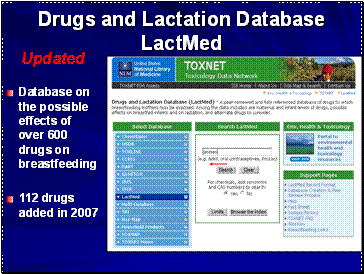
LactMed: Drugs and Lactation Database: Updated
- Database on the possible effects of over 600 drugs on breastfeeding
- 112 drugs added in 2007
LactMed is a one-year-old database on the possible effects of over 600 drugs on lactation, breastfeeding, and the breastfed infant. It is designed for health professionals, such as ob/gyns, pediatricians, midwives, nurses, as well as lactation consultants and nursing mothers. 112 new drugs were added in 2007. LactMed has brought many new users to TOXNET, especially health professionals.
Slide 30
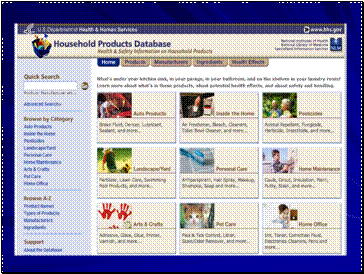
Household Products Database
Here’s the redesigned look, just released last week.
1,000 new products , now has over 8,000 products including 1500 MSDS.
One of our most heavily used resources.
Slide 31
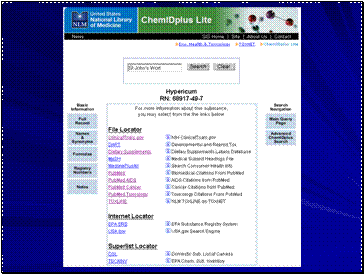
ChemIDPlus Lite
Just a reminder of ChemIDplus as a terrific tool for locating not only basic information ABOUT a chemical but also dozens of sources of additional information. For example, you’ll see a search here on St. John’s Wort points you to the new Dietary Supplements Labels Database as well as PubMed searches and other resources. In the last year, there were many improvements to the file locator, over 160,000 changes I’m told.
Also new this year, are additional radiological agents, vaccines, and chemicals that can be used as weapons.
That ends our whirlwind tour of what’s new with environmental health Internet resources and databases from SIS.
Slide 32
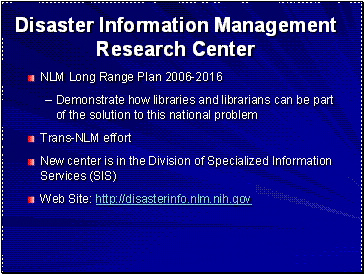
Disaster Information Management Research Center
- NLM Long Range Plan 2006-2016
- Demonstrate how libraries and librarians can be part of the solution to this national problem
- Trans-NLM effort
- New center is in the Division of Specialized Information Services (SIS)
- Web Site: //disasterinfo.nlm.nih.gov
As a bonus, I thought you might be interested in a new effort and office in the Specialized Information Services division. You’ll be hearing a lot about this during the conference. NLM has created a new Disaster Information Management Research Center that’s been unfolding over the last year and just became official this month.
It’s based on Recommendation 1.6. of NLM’s Long Range Plan, “quote” Establish a Disaster Information Management Research Center at NLM to make a strong commitment to disaster remediation and to provide a platform for demonstrating how libraries and librarians can be part of the solution to this national problem.
All divisions of NLM and certainly the National Network of Libraries of Medicine will be working together on disaster information and on disaster readiness for libraries.
Slide 33
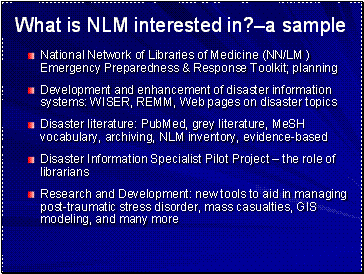
What is NLM interested in ? – a sample
- National Network of Libraries of Medicine (NN/LM ) Emergency Preparedness & Response Toolkit; planning
- Development and enhancement of disaster information systems: WISER, REMM, Web pages on disaster topics
- Disaster literature: PubMed, grey literature, MeSH vocabulary, archiving, NLM inventory, evidence-based
- Disaster Information Specialist Pilot Project – the role of librarians
- Research and Development: new tools to aid in managing post-traumatic stress disorder, mass casualties, GIS modeling, and many more
What are we interested in?
Here are some examples of the Center’s interests…
How librarians can assist health professionals and emergency managers with disaster information needs
Pilot Sites :
- NYU
- USHUHS/Bethesda Naval Medical Center
- Sarasota Hospital
- NIH Library/Assistant Secretary for Preparedness and Response
- Bethesda Medical Libraries Emergency Preparedness Partnership
********
- RML back-up partnerships established
- RML disaster plans completed
- NN/LM members encouraged to develop disaster plans and back-up partners
- NN/LM Emergency Preparedness and Response Toolkit ( http://nnlm.gov/ep)
- Plans to enhance Go Local emergency and disaster preparedness and response resources
***********
- Bethesda Hospitals Emergency Preparedness Partnership Research Projects
- Communication and data transfer tools
- Patient identification and tracking
- Medical record interoperability
- Disaster simulations in virtual worlds
- Disaster Informatics Research Grants
- Scalable Information Infrastructure research projects
Slide 34
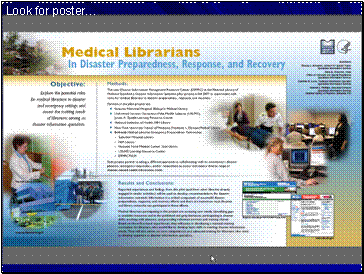
Look for poster..
There’s a poster presentation about the Disaster Information Specialist Pilot Project.
Slide 35
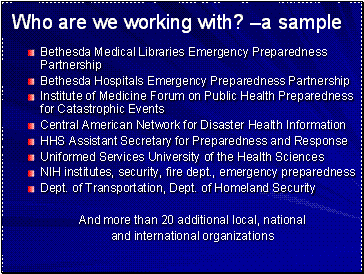
Who are we working with? – a sample
- Bethesda Medical Libraries Emergency Preparedness Partnership
- Bethesda Hospitals Emergency Preparedness Partnership
- Institute of Medicine Forum on Public Health Preparedness for Catastrophic Events
- Central American Network for Disaster Health Information
- HHS Assistant Secretary for Preparedness and Response
- Uniformed Services University of the Health Sciences
- NIH institutes, security, fire dept., emergency preparedness
- Dept. of Transportation, Dept. of Homeland Security
And more than 20 additional local, national and international organizations
I’ve included some of our partners here to give you an idea of who we’re working with. Keep in mind, though, that this is a very inclusive project. Everyone, and certainly everyone involved in library work, has a role to play in disaster readiness.
Thank you for your interest in what’s new with environmental health and toxicology at NLM. There are lots of materials here at the booth about our various products and projects.
You’re always welcome to contact SIS.
Gale Dutcher and I will be here for the duration and will be glad to talk further with you.
Are there any questions?
Slide 36
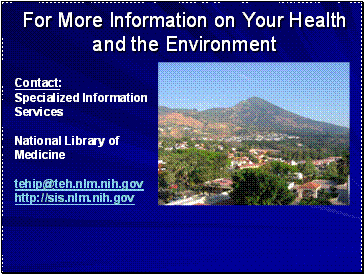
For More Information on Your Health and the Environment
Contact: Specialized Information Services, National Library of Medicine
I hope we’ve highlighted some of NLM’s long-standing and upcoming resources on environmental health. There are many other interesting activities in NLM’s Specialized Information Services division which we did not get to highlight today, so please contact us if you have any questions or want more information.
Thank you for your time.
Last Reviewed: June 5, 2008

